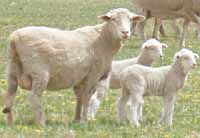| Livestock grazing in fields or pastures frequently capture the attention of Carbon County residents and visitors to the valley, especially when the herds include young animals. While Carbon County is neither a state leader nor a powerhouse in the production of agricultural products in Utah, the industry of growing crops and raising animals still represents an important activity to numerous local residents. |
While neither a state leader nor a powerhouse in the production of agricultural products in Utah, the industry of growing crops and raising animals is still an important activity to numerous Carbon County residents.
Early settlers in Carbon County relied on agriculture for their daily sustenance, just as the majority of Utahns did.
The situation changed when local residents turned to mining coal and the railroad came through the county in the 1880s.
Not only did the main workforce switch from agricultural to industrial based employment, but the population changed as well.
However, the agricultural base has carried on and many people in the county who work in the coal mines or local industries continue to operate small farms.
No major farming operations are left in the area, but several large ranches continue to add to the local agricultural base.
The data compiled in the latest report issued by the Utah Department of Agriculture and Food shows that production is still going on, although the lack of water the last few years has curtailed some production in the area.
Carbon has so little grain production that the county is not listed in the report.
But when it comes to alfalfa and hay, the area has a number of acres planted with the crops.
In fact, alfalfa and hay represent the biggest agricultural crops raised in the area.
During 2001, 6,000 acres of land in Carbon County were planted in hay, but the figure decreased to 5,700 in 2002.
The yield per acre went down as well, with 3.2 tons being harvested per acre in 2001 and only three tons in 2002.
Total production at operations in the county also dropped during the one-year period, with only 16,900 tons of hay harvested in 2002 as compared with 18,900 in 2001.
Of the total of hay crops, 4,800 acres were planted in actual alfalfa during both years in Carbon County.
The yield for alfalfa was down as with all hay crops in the county, decreasing from 3.5 tons per acre in 2001 to 3.2 tons per acre in 2002.
Total tonnage of harvested hay in Carbon County for 2001 registered at 16,600 tons, while 15,400 tons were hauled off the local fields in 2002.
In comparison, the highest producing Utah region for hay in 2002 was Box Elder County.
Box Elder reported 243,100 tons of harvested hay with a yield of 3.8 tons per acre.
The lowest hay production came from Daggett County, where only 9,800 tons were harvested per acre .
The tonnage of hay per acre in Daggett County registered at two.
In terms of Carbon County’s other major agricultural activities, cattle production has remained at nearly the same level. However, a sub-category, beef cattle production, rose slightly in Carbon County during 2002.
Overall, the county’s cattle production in 2001 and 2002 was listed by the state as 11,000.
The number of beef cattle produced in Carbon County in 2001 registered at 6,000. In 2002, the number decreased to 6,500.
Carbon County is not listed in the report’s milk cow category.
The majority of the cows in the local area basically supply milk for individual consumption, with no significant commercial value.
Statewide, the largest cattle producing county was Box Elder County. Box Elder reported a total cattle production figure of 105,000. Of the total, 33,000 head of the livestock were beef cattle.
The lowest cattle production in the state took place in Grand County. Grand County’s total was 3,000, with 2,000 beef cattle included in the figure.
In the breeding sheep and lambs category, Carbon County produced 5,800 head last year.
The state’s leader in the category was Sanpete County, with 57,800 sheep and lambs.
The data compiled by the state agriculture department indicate that livestock production dollars in Carbon County climbed from the $4.9 million reported during 2001 to $5 million in 2002. However, the overall gain posted by livestock was offset by a lower value in local agricultural crops.
In 2001, estimated sales in Carbon County registered at $1.2 million, slightly higher than the $1.1 million last year). Both years ended up with the same overall total of $6.1 million in sales of agricultural products.
The county in the state that made the most money off agriculture last year was Beaver County which edged out Sanpete for the lead with $114.3 million in sales compared to Sanpete’s $109.8 million. The county with the lowest agricultural income listed was Daggett with $2.3 million in sales last year.
The totals for this year will not be available until next summer, but it appears that they could be down in many areas due to the drought situation. However, since the price of beef has gone up in the past few months, ranchers may realize more dollars for their herds, which could bring up the dollar value.
Overall the state as a whole ranks sixth in the nation in sheep production, 13th in alfalfa production and 28th in beef production. Utah ranks 35th out of all states in the total number of farms with 12 million acres in agricultural production. The state ranks 26th in the amount of land contained within farming acreage. Raw agricultural products generate $1 billion dollars a year in the state and over 100,000 people are employed in some way in agriculture.

